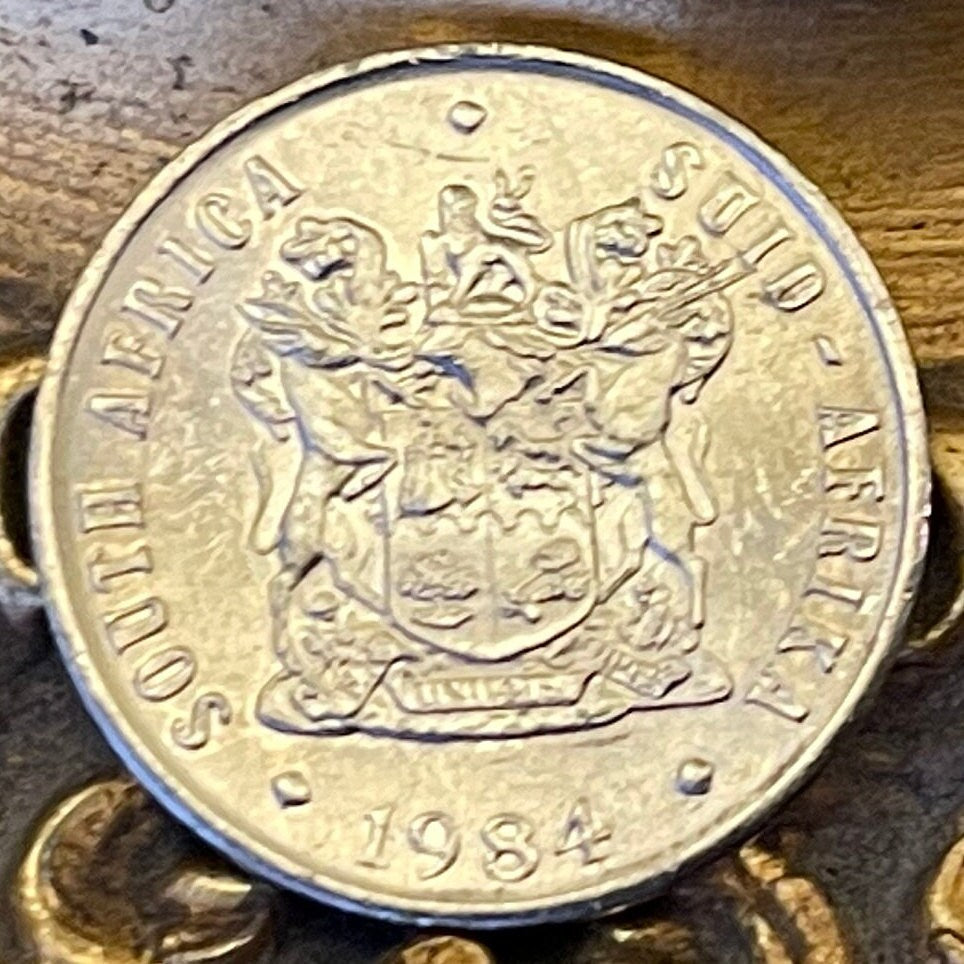elemintalshop
Mopane Aloe 10 Cents South Africa Authentic Coin Money for Jewelry and Craft Making (Power Through Unity) (Lotion)
Mopane Aloe 10 Cents South Africa Authentic Coin Money for Jewelry and Craft Making (Power Through Unity) (Lotion)
Couldn't load pickup availability
Mopane Aloe 10 Cents South Africa Authentic Coin Money for Jewelry and Craft Making (Power Through Unity)
Reverse: Mopane Aloe plant (Aloe littoralis) with denomination above
Lettering: 10
Obverse: South Africa coat of arms with the motto "Ex Unitate Vires" (Power Through Unity)
Lettering: SOUTH AFRICA · SUID-AFRIKA
EX UNITATE VIRES
Features
Issuer South Africa
Period Republic of South Africa (1961-date)
Type Standard circulation coin
Years 1970-1989
Value 10 Cents
0.10 ZAR = USD 0.0068
Currency Rand (1961-date)
Composition Nickel
Weight 4.0 g
Diameter 20.7 mm
Thickness 1.7 mm
Shape Round
Technique Milled
Orientation Medal alignment ↑↑
Number N# 833
References KM# 85, Hern# D130-135, 137-138, 140-141, 143-149, Schön# 124
Origin and Habitat:
Aloe littoralis is a widespread species ranging from the Limpopo Province in South Africa, to the Zimbabwe, Botswana, Zambia, Angola and Namibia.
Altitude range: 200–1065 metres above sea level.
Habitat and ecology: This species grows in flat, shallow depressions and open seasonal pans, on sandy soils in open bushveld, mopane woodland and grassland, occasionally on calcrete and rocky outcrops. It is particularly frequent through the coast region in coastal hills, but many specimens can be seen near little village (cultivated?). Its preferred habitat is characterised by summer rain and very dry, warm to cool winters.
Description:
Aloe littoralis is a perennial succulent herb or small tree, solitary, usually with a thick single-stem, 2-4 m tall clothed with persistent withered leaves. An apical rosette of 30-40 grey-green to reddish leaves about 60 cm long crown the tip of the stem. The leaves are slightly curved with the upper slightly channelled and the lower convex. This species is easily distinguished from other tall-stemmed aloes by its much-branched inflorescence up to 1.5 metres tall with numerous, narrowly cylindrical, erect racemes (spikes) of pink to red flower with yellow at mouth. This distinguishing feature can be used in the field to identify this plants, as it can be seen on dead inflorescences which endure for many months.
Derivation of specific name: Latin adjective “littoralis”, pertaining to the sea-shore, first collected near the coast in Angola
Stem: Main stem 2-4 m tall, simple usually erect, as thick as a man's arm, rarely thicker entirely covered with the remains of the old leaves. Populations from the open pans in northern Botswana tend to produce acaulescent plants.
Leaves: 30 to 40 succulent in a compact rosette. Lamina ensiform, lanceolate, acuminate, slightly channelled above and convex beneath 30-65(-90) cm long, 5-13 cm wide low down, arcuate-erect with lower leaves slightly spreading, greyish-green to yellowish green, sometimes tinged reddish in dry conditions, unspotted, or with few white spots on upper and lower leaf surfaces on young plants. Margin cartilaginous, yellow, with stiff reddish-brown teeth, spreading, horny, deltoid, 2-4 mm long and 10-15(-20) mm apart. Sap drying yellow.
Inflorescences: Scape 1.0-1.5(-2) m tall above the leaf rosette including the inflorescence, up to 10-branched, the lower branches normally rebranching. Branches arching upwards bearing the racemes erect, subtended by deltoid bracts about 15 mm long and 15 mm wide, with a few sterile bracts below each raceme. Racemes conical-cylindrical, sparsely flowered, 30-60 cm long and about 6 cm in diameter. Bracts ovate-lanceolate, rather longer than the pedicels 9-18 mm long 4-8 mm broad, 5-many-nerved, whitish and deflexed in fruit. Pedicels 6–10 mm long elongating to about 15 mm in fruit.
Flowers: Rose-red or pink turning yellowish near the tips, rarely dirty yellow, cylindric-trigonous, 23-34 mm long, 6 mm in diameter across the ovary. Perianth 25 mm long; tube very short. Outer segments fused in lower half, with slightly recurved tips; inner segments free but fused to outer in lower half. Pedicels 6-8(-12) mm long. Stamens as long as the perianth. Anthers exserted 1-5 mm. Ovary 5-8 mm long, 2-4 mm broad, olive-green. Style exserted 2-10 mm.
Blooming season (in habitat): Variable according to locality (In South Africa mainly from February to March, in Namibia from July to August).
Fruit (capsules): Oblong-ovoid, pale greyish-brown18-28 mm long, 10-15 mm in diameter.
Seeds: About 8.5-9 mm long, 4-4.5 mm broad and 1.5 mm thick, charcoal-grey, with broad, white or pale grey, dark-spotted wing.
Source: http://www.llifle.com/Encyclopedia/SUCCULENTS/Family/Aloaceae/12293/Aloe_littoralis
*****
Wikipedia:
The coat of arms featured a shield quartered. In each quarter was a symbol of the four provinces of South Africa. An ox wagon representing Transvaal Province, a woman with an anchor representing Cape Province, two wildebeests representing Natal Province and an orange tree representing the Orange Free State Province. The crest of the arms featured a lion holding four bound sticks. The supporters were a springbok and a gemsbok. Below the arms was the Latin motto, Ex Unitate Vires (translated as "Union Is Strength" but from 1961, translated as "Unity Is Strength").
The blazon (formal description of the arms in heraldic terms) is: "Quarterly per fesse wavy First Quarter Gules a female figure representing Hope resting the dexter arm upon a rock and supporting with the sinister hand an Anchor Argent Second Quarter Or two Wildebeesten in full course at random both proper Third Quarter Or upon an island an Orange tree Vert fructed proper Fourth Quarter Vert a Trek Waggon Argent And for the Crest On a Wreath of the Colours A Lion passant guardant Gules supporting with the dexter paw four staves erect alternately Argent and Azure and branded Or And for the Supporters, On the dexter side A Spring Buck and on the sinister side An Oryx (Gemsbuck) both proper together with the motto EX UNITATE VIRES."
Share

















